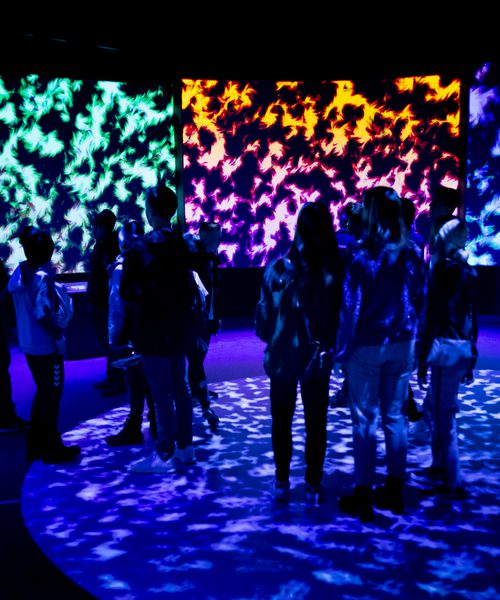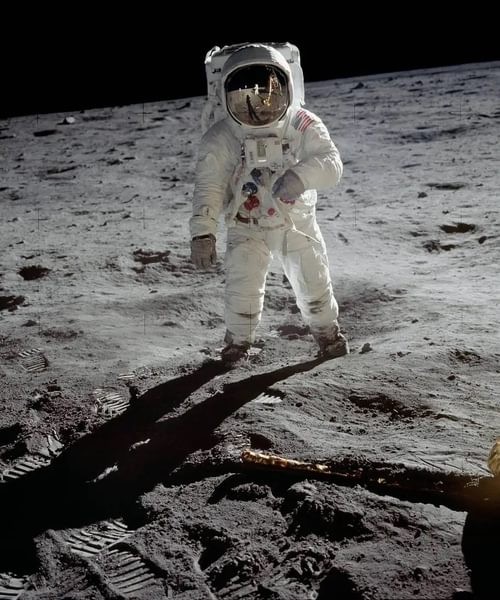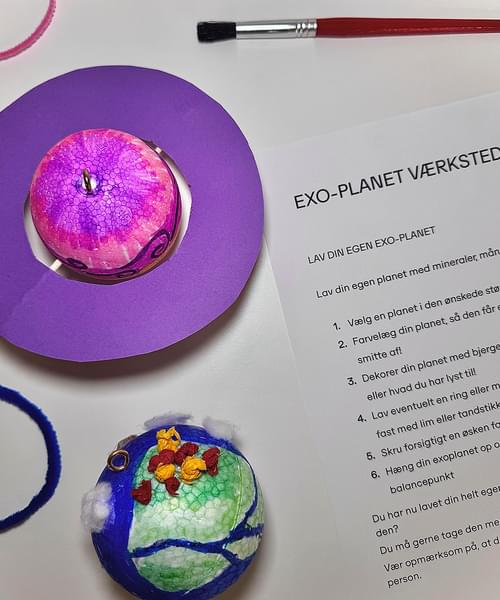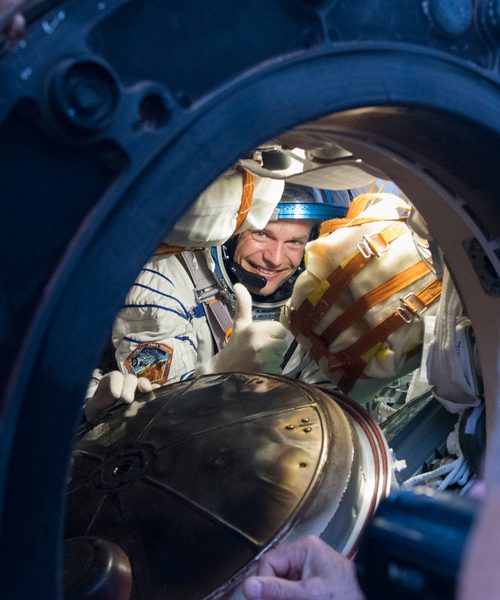
The Solar System
Take a journey around our solar system
4.6 billion years ago in our galaxy, the Milky Way, a small part of a gigantic cloud of dust and gas collapsed. Here were molecules and atoms that later became the building blocks of stars, planets and all the life we have here on Earth, including us humans. It was at the centre of such a cloud of atoms and molecules that the Sun was created. The elements were pulled together by gravity and the matter falling towards the centre of the cloud became so hot that hydrogen could fuse and become helium.
Further away from the Sun, where the temperatures were lower, the planets were formed. In our solar system we have eight planets: Mercury, Venus, Earth, Mars, Jupiter, Saturn, Uranus and Neptune. Pluto, once considered a planet, is now categorised as one of the five dwarf planets in the Solar System. In addition to the Sun, planets and dwarf planets, our solar system also consists of moons, comets and asteroids.
The Sun
All planets in the solar system orbit our own star, the Sun.
The Sun - the star at the centre of our solar system - is located in one of the arms of the Milky Way and makes up 99.8% of the solar system's mass. The planets make up only 0.2% of the mass of our solar system. Although the Sun is a so-called ‘yellow dwarf star’, our solar system's star is among the top 5% of the largest stars in the Milky Way and is 333,000 times the size of Earth.
Like all stars, the Sun is a ball of glowing gases. These are mainly hydrogen and helium. In the 15 million degree hot and violent environment of the Sun's core, hundreds of millions of tonnes of hydrogen nuclei turn into helium every second. This is how the Sun produces energy. On average, it takes hundreds of thousands or even millions of years for the energy to reach the Sun's surface.
The Sun radiates energy in all wavelengths of the electromagnetic spectrum - both the light we can see, but also UV, infrared, radio and gamma radiation that we humans cannot see. However, we can see the Sun in different wavelengths with a variety of telescopes that are sensitive to different parts of the electromagnetic spectrum.
When Galileo Galilei pointed his telescope at the Sun, he discovered sunspots - areas of the visible surface that are about 2000 degrees colder than the rest of the surface. The sunspots look like dark areas on the solar disc, but they only look dark because they are colder than their surroundings. The Sun is a key driver of the Earth's environment and the most important condition for life on our planet. Therefore, the study of the Sun is an important branch of astronomy and can, for example, give us more knowledge about the rich activity in the Sun's atmosphere, where millions of tonnes of material are regularly ejected in solar explosions.

Mercury
Mercury is the closest planet to the Sun with an average distance of approximately 58 million kilometres.
Mercury is the smallest of the planets in our solar system - it's not much bigger than the Moon! The ancient Greeks believed that Mercury was two planets. When Mercury was east of the Sun, they called the planet ‘Apollo’, and when it was west of the Sun, they called it ‘Hermes’. However, the Greek philosopher and mathematician Pythagoras discovered that there was only one planet. Today, science faces many challenges in learning more about Mercury. Mercury is difficult to see from Earth, and the Hubble Space Telescope, which is in orbit around Earth, cannot look directly at Mercury because the Sun's heat and light will damage the precious telescope.
However, NASA has launched missions to learn more about the innermost planet of our solar system. The Mariner 10 spacecraft passed the planet three times in the mid-1970s, and the Messenger spacecraft flew past Mercury three times from 2008-2009, and in 2011 was put into orbit around the planet. Messenger crashed on Mercury in 2015 after the spacecraft ran out of fuel. Mercury is named after the Roman god, which is similar to the Greek Hermes. Just as the winged messenger of the gods moved quickly, Mercury's orbit around the Sun lasts only 88 days - twice as fast as Mercury's 176 Earth days. Mercury has almost no atmosphere, and among the planets of the Solar System, Mercury is the planet with the largest temperature fluctuations - from a whopping 430℃ during Mercury's day to -183℃ during Mercury's long night.

Venus
Venus is named after the Roman goddess of love and has a surface temperature of around 480℃.
The warm temperature of Venus is due to the fact that Venus' atmosphere consists almost entirely of CO2, which is a greenhouse gas. This means that the heat is kept within the atmosphere just like in a greenhouse. The dense cloud layer around Venus consists of concentrated sulphuric acid and it also rains with sulphuric acid, but because Venus is so hot, the rain never reaches the planet's surface.
Planets do not shine by themselves, but they reflect light from the Sun. Venus is the brightest planet in our solar system because its cloud layer reflects the Sun's light. It shines so brightly that it has led to a number of misunderstandings throughout history.
During World War 2. During World War II, fighter pilots sometimes fired shots at Venus because they thought it was an enemy aircraft, and Venus' bright light has given rise to many rumours about UFOs. While the surface of Venus cannot be seen directly because the planet is covered by a thick layer of clouds, from 1990-1994 NASA's Magellan spacecraft captured images of what was hiding behind the clouds using radar technology. The images revealed a barren, flat rocky landscape, occasionally covered by mountains, valleys and extinct volcanoes.
Venus is our closest neighbour in the Solar System, and you can find several similarities between Venus and Earth. The two planets are almost the same size and there is only a 2% difference in the material they are made of.

Earth
Our own planet Earth is the third in line of planets from the Sun.
Earth's distance from the Sun, its gravity, and Earth's atmosphere all contribute to creating the conditions for liquid water. Approximately 2/3 of the Earth's surface is covered by water, which was essential for life on Earth to emerge. Earth is still the only planet where we know for sure that life exists. How and when life on Earth originated is still hotly debated. Life on Earth is about 4 billion years old, while Homo sapiens emerged about 200,000 years ago - human evolution is therefore only a very small part of Earth's history.
Earth's appearance has changed a lot since the planet was formed around 4.6 billion years ago. The lithosphere, Earth's crust and the upper part of the mantle, is divided into a series of plates that have collided, pushed apart, and scraped up and down against each other throughout Earth's history. The tectonic plates only move a few centimetres a year, but it has been enough for the Earth's continents to form one supercontinent several times. The last time this happened was around 200 million years ago, when our planet was dominated by the supercontinent Pangaea.
Below the crust is the Earth's mantle - the largest part of the Earth's interior, which consists mainly of solid rock, yet has a gritty, semi-liquid consistency. At the very centre of our planet is a core of nickel and iron that is as hot as the surface of the Sun, but because the pressure is so high, the innermost part of the core cannot melt. However, the inner part of the core spins around in a liquid outer core, and it is the currents in the outer core that, together with the Earth's rotation, cause the Earth's magnetic field. It is not possible to drill down to the Earth's core, but we know about the Earth's internal structure from measurements of seismic movements inside the Earth. Seismic measurements are taken, for example, when an earthquake occurs. Waves travel through the Earth, and these waves behave differently depending on what material and where in the Earth's interior they are located.

The Moon
The Moon's landscape is barren and covered in craters caused by meteor impacts.
Most of the craters date from early in the Moon's history, from the period known as the Late Heavy Bombardment, approximately 4.1-3.8 billion years ago. Because the Moon has no atmosphere, the meteors meet no resistance until they collide with the lunar surface and there is no wind and weather to erase the craters. Large meteor impacts happen much more rarely today. One of these craters, Tycho, is named after the Danish astronomer Tycho Brahe. Although the Moon's gravity is only 1/6 of the Earth's, both the Moon's and Earth's shape changes slightly due to each other's gravity. The tides here on Earth are a result of the attraction of the Moon.
Satellites are not just man-made constructions that can help us observe and collect data, watch TV and listen to the radio, or communicate. A satellite is defined as something that orbits a celestial body. The moon orbits the Earth and we call it a natural satellite. Our moon is one of over 170 known moons in the Solar System. From Earth, we always see the Moon from the same side. It has what is called a bound rotation. During the six Apollo landings from 1969-1972, astronauts collected large amounts of data about the Moon.

Mars
The surface of Mars is made up of volcanic basalt and is rich in iron - that's why it's red.
Small amounts of water have been found floating on the surface of Mars, which is an essential condition for life. However, there is almost no atmosphere on Mars, which is believed to be the reason why the water that was probably once found in rivers and lakes on Mars' surface has long since evaporated.
Occasionally, dust storms can occur in the planet's desert-like landscape, capable of covering the entire planet. Mars has ice caps at both poles. The northern hemisphere has flat lava plains and large inactive volcanoes at the equator, while the southern hemisphere is dominated by many craters from meteor impacts. Over the past 60 years, more than 40 missions have been sent to study Mars. Mars has been studied by spacecraft that have flown past, orbited or landed on the planet's surface. One of them is Curiosity, which landed on Mars in 2012. Curiosity is a rover, which is a robot with wheels. It is still travelling on the surface of Mars and is equipped with cameras and measuring instruments to learn more about the planet. There are plans to send another rover mission to Mars in 2020 and options are being explored to send a team of astronauts to Mars.
Throughout history, many have believed that the red planet harboured intelligent life. In the 1800s and early 1900s, ideas such as signalling to Martians using a giant sign marked in the snowy landscape of Siberia and that Martians had built an intricate system of canals on the surface of Mars abounded. Others, as recently as the 1970s, were convinced that there were pyramids on Mars hundreds of times the size of the Egyptian pyramids.

Jupiter
Jupiter's mass is two and a half times greater than the mass of all the other planets combined.
Jupiter is almost five times as far away from the Sun as Earth, and the length of Jupiter's years is equivalent to 12 Earth years. A gas giant like Jupiter is mostly gas, but it is possible that there is a solid core at the centre of Jupiter's interior that is about the same size as Earth.
The only thing visible from Earth is the upper layers of Jupiter's atmosphere. Jupiter's thick atmosphere is dominated by strong winds, turbulent clouds and electrical storms that could destroy Earth. Jupiter's Great Red Spot, for example, is a storm three times the size of Earth. Due to Jupiter's strong magnetic field, there are also large, beautiful auroras. The transition between planet and atmosphere is literally fluid - below the atmosphere we encounter hydrogen in liquid form. This giant planet contains the largest ocean in the solar system, but there are no waves and no surface. We know of 79 moons in orbit around the large planet. Jupiter's moons are more similar to Earth than Jupiter itself.
Io is the innermost of Jupiter's moons and there is constant volcanic activity. The moon Europa is covered in water ice, and it is possible that liquid water could be found below the surface. In addition, it has a thin atmosphere that consists primarily of oxygen, so many believe that Europa seems like one of the places in the universe where humans could live in the future. Ganymede, the largest moon in the solar system, is larger than the solar system's innermost planet, Mercury. If Ganymede were orbiting the Sun instead of Jupiter, it could be categorised as a planet.

Saturn
All the gas giants are surrounded by rings. The rings consist of small pieces of ice and rock.
The contents of rings around planets can be as small as dust grains, but you can also find objects that are several metres across. Saturn's rings, which are the brightest of all the rings in the Solar System, are particularly famous. When Galileo Galilei observed the rings, he marvelled at what looked like two protruding ‘ears’ or ‘handles’ on either side of Saturn. However, Dutch mathematician and astronomer Christiaan Huygens discovered that the ‘ears’ were rings around the planet. We now know that Saturn's rings are made up of tens of thousands of fragments of ice and rock.
Saturn is mainly made up of hydrogen and helium. The beautiful planet is almost as big as Jupiter, but Saturn's density is so low that if placed on a gigantic ocean, it would float on top of the water surface. Just like Jupiter, there are constant storms in Saturn's atmosphere. Saturn's rapid rotation around itself causes very high wind speeds and storms can last for months.
At least 82 moons are in orbit around Saturn. There are eight large moons, the largest of which is Titan, which was also discovered by Christiaan Huygens. Titan is the only moon in the Solar System that has a thick atmosphere - it's actually thicker than Earth's. Titan's atmosphere consists primarily of nitrogen, and on Titan's surface, lakes of methane, ethane and propane have been discovered, all of which are hydrocarbons. Hydrocarbons are organic substances that are compounds of carbon and hydrogen - all life here on Earth is made up of these types of chemical compounds. Therefore, the building blocks for life are present on Titan, but the moon is not an obvious place to find life. The surface temperature is -180℃, so the ice that covers much of Titan's surface is as hard as rock.

Uranus
Uranus and Neptune are largely unexplored territories.
Uranus is barely visible to the naked eye and it wasn't until 1781 that the German-British astronomer and composer, Sir Frederick William Herschel, discovered with his telescope that Uranus was not a star. Instead, Herschel claimed that it was a comet, but this raised controversy in astronomical circles and more people began observing Uranus. Two years later, Herschel accepted that it was a planet. After a number of different names were suggested, Uranus was eventually named after the Greek sky god.
Only one mission has explored the two gas giants that are the outermost planets from the Sun: Voyager 2, which passed Uranus in 1986 and Neptune in 1989. Uranus has a blue-green colour because the methane gas in its atmosphere absorbs red light and reflects blue light. Uranus' atmosphere is not as stormy as Jupiter and Saturn. On the other hand, its atmosphere is the coldest we can find on planets in the Solar System, with temperatures as low as -224℃. Uranus differs from the other planets in our solar system in that Uranus' rotation axis is tilted almost 97.8 degrees - almost as if the planet has been overturned and is rolling around the Sun in its orbit. There is disagreement as to why Uranus rotates so ‘crookedly,’ but one explanation is that the unusual tilt is due to a collision early in Uranus' history.

Neptune
Neptune takes 165 years to orbit once around the Sun. Neptune is home to the strongest winds in the Solar System - wind speeds of up to 2400 km/h have been measured.
Neptune, the furthest planet in our solar system from the Sun, was not directly discovered. In the 1800s, astronomers realised that Uranus was attracted to an unknown object. Neptune was therefore first mathematically predicted based on the calculations of French astronomer Urbain Le Verrier and British astronomer and mathematician John Couch Adams in 1845. The existence of our solar system's eighth planet was confirmed in 1846 by German astronomer Johann Gottfried Galle, close to the position calculated by Adams and Le Verrier.
We can't see Neptune with the naked eye, so we need the help of telescopes to observe the planet with its bright blue colour. The blue colour comes from the methane in Neptune's atmosphere absorbing the red wavelengths of sunlight. But the reason Neptune has such a bright blue colour is because the light penetrates deeper into the atmosphere than it does on Uranus, which has a pale green appearance.
When Voyager 2 flew past Neptune in 1989, the data collected by the spacecraft confirmed that there were 4-5 rings around Neptune. The rings were named after five men who all played pivotal roles in the discovery of Neptune: Adams, Le Verrier, Lassell, Arago and Galle.

Dwarf planets
In 2006, a new term was introduced for some of the objects in the Solar System.
Dwarf planets is a term given to globes that do not fulfil all three criteria to be a planet. One of the requirements is that a planet must have cleared its orbit of other objects. Pluto is located in an area called the Kuipter Belt, where there is a lot of material lying around.
This meant that Pluto was no longer a planet - it became a dwarf planet.

The Asteroid Belt
Moving on from Mars and away from the Sun, we find the Asteroid Belt, which consists of metallic and rocky objects orbiting the Sun.
Asteroids are remnants from when our solar system took shape, ranging from just a few millimetres in size to hundreds of kilometres in diameter. Around 200 million of the Asteroid Belt's asteroids are larger than 1 kilometre. There aren't many large asteroids in the asteroid belt, but many asteroids are thought to be parts of larger asteroids that were broken up as a result of collisions.
The asteroid belt between the orbits of Mars and Jupiter marks the separation between the planets of the Solar System that are primarily composed of rock and metal and those that are primarily made up of hydrogen and helium gas. It is not possible to land a spacecraft on Jupiter, Saturn, Uranus or Neptune - the so-called gas giants, which are only solid in their cores.







